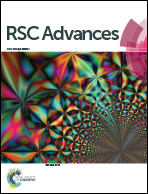Two-dimensional additive diethylammonium iodide promoting crystal growth for efficient and stable perovskite solar cells†
Abstract
Methylammonium lead iodide perovskite photovoltaics have attracted remarkable attention due to their exceptional power conversion efficiencies (PCEs). The film morphology of organometallic halide perovskite plays a very important role in the performance of planar perovskite solar cells (PVSCs). Previous methods have been explored to control the crystal growth for getting a compact and smooth perovskite film. Here, we report an effective and reproducible approach for enhancing the stability and the efficiency of PVSCs by incorporating a small quantity of two-dimensional (2D) material diethylammonium iodide (DAI) in three-dimensional (3D) MAPbI3, which can facilitate the perovskite crystallization processes and improve the resulting film crystal quality. The fabricated (DA2PbI4)0.05MAPbI3 perovskite hybrid films exhibit good morphology with larger grains and uniform morphology. Simultaneously, reduced defects and enhanced carrier lifetime within a full device indicate enhanced crystallization effects as a result of the DAI inclusion. The photovoltaic device attains a high photocurrent of 22.95 mA cm−2 and a high fill factor of 79.04%, resulting in an overall PCE of 19.05%. Moreover, the stability of the 10% DAI doped perovskite solar cell is also improved. These results offer a promising stable and efficient light-absorbing material for solid-state photovoltaics and other applications.



 Please wait while we load your content...
Please wait while we load your content...